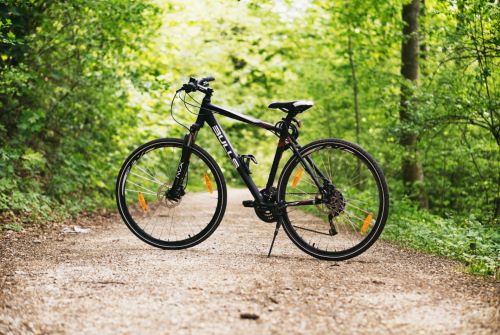

What steps do you take to maintain your bike’s performance throughout the year?
Regular bike maintenance serves multiple purposes beyond extending your bike’s lifespan. Regular bike maintenance protects you from dangerous situations while making your ride better and preventing expensive repairs through basic upkeep.
Recent statistical analysis shows that Americans invested almost $8 billion in bicycles and cycling accessories during 2021 which indicates strong appreciation for two-wheeled investments. The bicycle dealership and repair market in the United States with a projected value of $7.9 billion in 2025 demonstrates that proper maintenance is a major industry.
But here’s the thing…
With basic tools and some knowledge you can perform many necessary maintenance tasks directly at home. Or for all of your adjustment needs you can visit a bike shop Franklin.
This guide will introduce you to fundamental bike maintenance tips which cyclists at all skill levels need to know.
What you’ll discover:
- Essential Tools Every Cyclist Should Own
- Weekly Maintenance Checks You Can’t Skip
- Monthly Maintenance Tasks for Optimal Performance
- Seasonal Maintenance to Protect Your Investment
- When to Visit a Professional Bike Shop
Essential Tools Every Cyclist Should Own
Before starting maintenance work it is important to have the necessary tools ready. Equipping yourself with these fundamental tools will help you avoid wasting time and money while reducing stress.
Every cyclist should have:
- This multi-tool with Allen keys serves as a cyclist’s Swiss army knife because it manages most basic adjustments.
- Tire levers provide a crucial function for bike puncture repairs by enabling tire removal.
- The right tire inflation achieved through a floor pump with pressure gauge is one of the simplest maintenance tasks you can perform on your bike.
- Chain lubricant – Keeps your drivetrain running smoothly
- Use cleaning rags and brushes specifically for routine cleaning sessions.
Market research indicates that service centers stand as vital operations for bicycle stores due to increasing requests for e-bike repair work. The global bicycle market experienced a compound annual growth rate of 2.1% in the last ten years while showing significant expansion during the pandemic.
Weekly Maintenance Checks You Can’t Skip
Conducting weekly bike maintenance helps prevent mechanical problems and safety concerns.
Check your tire pressure. Tires that are inflated to the right level perform better because they roll more swiftly and offer better handling while also providing enhanced resistance against punctures. The sidewall of your tires displays the recommended pressure range. Underinflated tires cause:
- Increased rolling resistance
- Higher risk of pinch flats
- Poor handling and control
Clean and lubricate your chain. The performance of your shifting system decreases and your chain wears more quickly when it remains dirty or dry. Begin by cleaning the chain with a clean rag then apply lubricant sparingly followed by wiping off any excess.
Quick brake check. Test the brake levers by squeezing them to confirm proper engagement and to check that they do not rub once released. Inspect brake pads for signs of wear because they must be changed if they approach the wear line.
Visual inspection. Perform a fast visual check on your bike to spot loose bolts and cracked components along with any unusual features. Regular 5-minute inspections prevent incidents and reveal minor problems before they turn into major ones.
Monthly Maintenance Tasks for Optimal Performance
Performing maintenance dives on a monthly basis helps keep your bike functioning at its best for extended times.
Check your drivetrain. Inspect your chain, cassette, chainrings, and derailleurs for significant wear patterns. The degradation of your chain leads to accelerated damage of other components while diminishing your bike’s shifting performance.
Inspect your cables. Shifter and brake cables tend to stretch and fray with regular use over time. Search for any indications of rust coverage, frayed edges, or twisted sections. You should consider replacing or adjusting your cables if you experience slow shifting or diminished braking ability.
Clean your entire bike. Every month your bike needs a complete cleaning. Clean your bike with products made specifically for bicycles to protect the frame and components and refrain from using high-pressure water because it risks damaging bearings and electrical parts on contemporary bikes.
Check wheel trueness. Spin both wheels to determine if any wobbling occurs. When wheels are not even it results in impaired braking and handling while also creating potential spoke-related problems. Minor wheel truing is possible at home using a spoke wrench yet significant wobbles should be handled by professionals.
The bicycle market has grown steadily during the last ten years and as a result more cyclists are now prioritizing proper maintenance. Service department operations research reveals regular maintenance substantially cuts down future major repair requirements.
Seasonal Maintenance to Protect Your Investment
The transition between seasons stands out as an ideal period for executing extensive maintenance tasks on your bicycle.
Spring Tune-Up
Your bike requires special maintenance before being used again after being stored throughout winter.
Thorough cleaning and lubrication. Get rid of all dirt buildup on your bike if it has been kept in storage throughout winter. The drivetrain needs careful inspection because it might have gathered dust or rust during storage.
Check all bearings. The inspection process should cover wheel hubs along with bottom bracket and headset components. Components that exhibit grinding sensations or looseness signify a need for servicing.
Inspect the frame. Examine the bike frame for hidden cracks, dents, or other forms of damage. Perform a detailed inspection of carbon frames to identify any potential damages.
Fall Preparation
When riding season ends in various locations bike owners must prepare their bicycles for storage or reduced use.
Deep clean everything. Before putting your bike into storage or during periods of infrequent winter use it is essential to eliminate all dirt and grime along with moisture.
Apply frame protection. A bike-specific wax or protectant layer can protect against corrosion during storage.
Check tires. To prevent flat spots while storing your bike for a long time hang it to distribute its weight or rotate the wheels from time to time.
According to the latest market analysis proper seasonal maintenance boosts bike longevity by 40% making it among the best methods for safeguarding your cycling investment.
When to Visit a Professional Bike Shop
Although you can perform many bike maintenance tasks independently, professional assistance is essential for certain complex maintenance duties. Market research findings show the service center as an essential segment for bicycle shops because specialized repairs demand continues to grow.
Professional bike shop visits are recommended when
Your bike makes unusual noises. Unusual creaking, clicking and grinding noises from your bike usually signal problems that need a professional evaluation.
Your brakes aren’t working properly. Fixing brake issues requires specialized knowledge and presents significant danger when done incorrectly.
Your shifting is off. You can handle basic derailleur adjustments yourself but should consult a professional for complex shifting issues.
After a crash. Professional evaluation is needed to identify frame alignment problems and hidden damage even when it is not visibly detectable.
A great bike shop offers more than repairs by teaching customers proper maintenance techniques and offering customized advice tailored to their riding preferences and conditions.
Wrapping It Up
Maintaining your bike regularly serves purposes beyond aesthetics since it ensures safety and performance while protecting your investment. The $8 billion Americans spend yearly on bicycles and accessories shows that cycling extends beyond a hobby for many people and requires appropriate maintenance for a proper lifestyle.
Consistent maintenance practices lead to effective bike upkeep. Regular attention prevents major bicycle problems in the future.
Remember these key takeaways:
- Performing weekly inspections serves as your primary protection against routine bicycle problems
- Monthly maintenance keeps performance optimal
- A complete bike overhaul at the start of each season ensures optimal protection as riding conditions change.
- When dealing with complicated issues, professional service proves to be a valuable investment.
Regular maintenance tips will lengthen your bike’s lifespan while enhancing the safety and comfort of your riding experience.


